first level title
Overview
Through this article you can learn about:
What is on-chain AI?
Why is there no on-chain AI yet?
The power of AI on-chain;
technical path;
The value of on-chain AI that I understand;
first level title
1. AI + blockchain =?
secondary title
1) Back to the most basic question, what is AI on-chain?
blockchainblockchainLet the AI modeltransparent + verifiable
To be more specific, AI chaining means the complete verification of the artificial intelligence model, which means that a model needs to disclose the following three points to the entire network (users or verifiers):
model architecture;
Model parameters and weights: Public parameters and weights sometimes have a negative impact on product security. Therefore, for specific scenarios, such as risk control models, weight can be hidden to ensure security;
Model input: In the web3 scenario, it is basically open data on the chain.
secondary title

2) What is the impetus for AI + blockchain?
The significance of the combination of AI and blockchain is not to replace the operation mode of the centralized Web2 artificial intelligence, but to:
Create the next stage of value for the web3 world without sacrificing decentralization and trustless. The current blockchain is like the early stage of web2, and it has not yet been able to undertake wider applications or create greater value. And only after adding AI, the imagination of dapp can really jump to the next stage, and these chain applications may be closer to the level of web2 applications. This approach is not more similar in function, but through the use of The value of the blockchain is improved in terms of user experience and possibilities.
Provide a transparent and trustless solution for the AI operation mode of the web2 black box.
Imagine the application scenario of web3:
Add the recommendation algorithm to the NFT trading platform, recommend the corresponding NFT based on user preferences, and improve conversion;
Add AI opponents in the game, more transparent and fair game experience;
……
but,These applications use AI to further improve the efficiency or user experience of existing functions.
- Is it worth it? have.
- Is it worth it? Depends on the product and scenario.
The value that AI can create has never been just the optimization of 99 to 100. What really excites me isBrand new app from 0 to 1, some only throughtransparent + verifiableThe use case that can only be realized by the on-chain model. However, these "exciting" use cases are currently mainly based on imagination, and there are no mature applications. Let's start with a few brain holes:
1. Through theNeural network's decision-making model for crypto trading:A product form may be more like an upgraded version of copy trading, or even a brand new trading method. Users no longer need to trust or investigate other experienced traders, but bet on a thoroughly open and transparent model and its performance. Essentially AI trades faster and more decisively based on predictions of future crypto prices. However, without the "trustless autonomy" that comes with AI on the chain, such betting objects or standards simply do not exist. Users/investors can transparently see the reason, process and even the precise probability of future rise/fall of model decision-making;
2. AI modelAs a referee:One product may be a new form of oracle, which uses AI models to predict the accuracy of data sources. Users no longer need to trust the validator, and do not have to worry about nodes doing evil. The oracle provider does not even need to design a complex node network and reward and punishment mechanism to achieve decentralization. Correspondingly, the transparent + verifiable AI on the chain is enough to meet the task of verifying the confidence of the data source off the chain. This brand-new product form has the opportunity to be crushed in terms of safety, efficiency and cost, and the decentralized object also jumps from humans to "trustless autonomy" AI tools, which is undoubtedly safer.
3. Large model-basedOrganizational management/operating system:The governance of DAO should be efficient, decentralized, and fair in essence, but the current status quo is running counter to it, loose and bloated, lacking transparency and fairness. The addition of AI on the chain can provide a very suitable solution, integrating the management model, Efficiency is raised to the highest level, and systemic and human risks in management are infinitely lowered. We can even imagine a brand-new development and operation mode of web3 projects. The entire framework and future development directions and proposals hardly rely on the development team or DAO voting to make decisions. Correspondingly, larger data acquisition based on large models Quantity and computing power far beyond human to make decisions. But the premise of all this is also that the model is on the chain. Without the "trustless autonomy" of AI, there will be no transition from people to tools in the decentralized world.
……
Summarize
The new product form based on AI on the chain can basically be summarized as changing the main body of decentralization and trustless from humans to AI tools, which is also in line with the evolution process of productivity in the traditional world. At the beginning, it is the main body of human beings who work hard and continue to upgrade Improve human efficiency, and later replace people with intelligent tools, subverting the original product design in terms of safety and efficiency.
secondary titletransparent + verifiable。
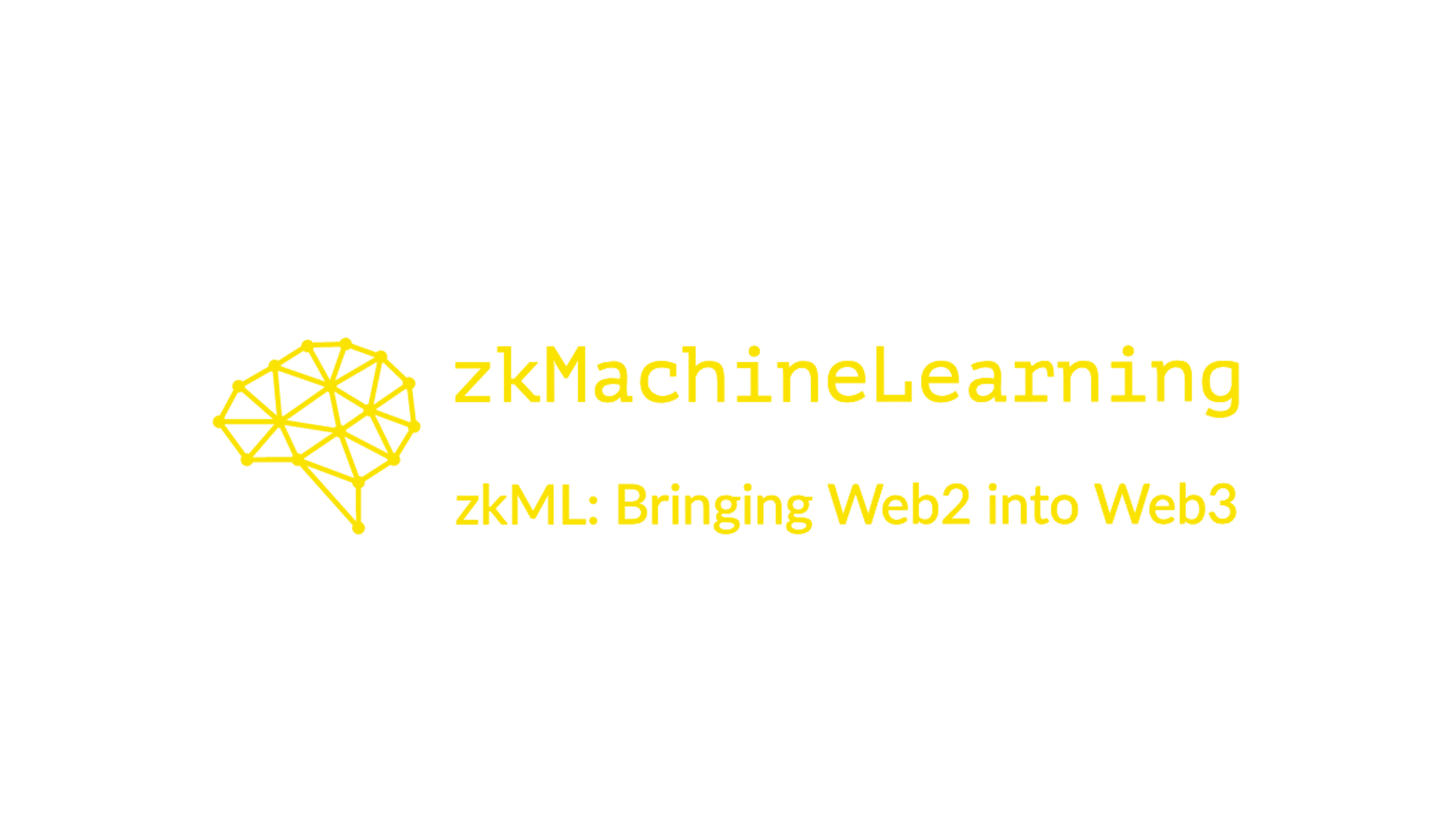
3) The next phase of Web3
As a phenomenon-level technological innovation, the blockchain cannot just stay in the primitive stage. Traffic and economic model are very important, but users will not always stay in pursuit of traffic or spend a lot of resources doing X to earn, and web3 will not get the next wave of new users onboard. But one thing is certain: the revolution in productivity and value in the web3 world must come from the addition of AI.
I think it can be roughly divided into the following three stages
Start: The update iteration of zero-knowledge proof algorithm and hardware provides the possibility for the first time for the emergence of AI on the chain;(we are here)
Development: Whether it is the improvement of existing applications by AI or the new products based on AI + blockchain, they are pushing the entire industry forward;
Endgame: What is the final direction of AI + blockchain?
The above discussion is to explore application scenarios from the bottom up through the combination of AI and blockchain, and look at AI + blockchain from a top down perspective. Will AI retrace the blockchain itself?
AI + blockchain = adaptive blockchain
Some public chains will take the lead in integrating AI on the chain, transforming from the level of the public chain to an adaptive one, and its own development direction no longer depends on the decision-making of the project foundation but based on huge data to make decisions, and the level of automation far exceeds that of traditional blockchains. form, so as to stand out from the current pattern of multi-chain prosperity.
With the AI blessing of verifiable + transparent, where is the self-regulation of the blockchain reflected, you can refer to several examples mentioned by modulus lab:
1. The trading market on the chain can be adjusted automatically in a decentralized manner, such as adjusting the interest rate of stablecoins in real time based on public data on the chain without trust assumption;
2. Multi-modal learning can allow the interaction of on-chain protocols to be completed through biometric identification, provide secure KYC, and achieve complete trustless identity management;
3. Allow the applications on the chain to maximize the value brought by the data on the chain, and support services such as customized content recommendations.
first level title
secondary title
1) What can Web3 provide for AI?
Infrastructure and ZK are undoubtedly the craziest introverted tracks in web3. Various ZK projects have worked hard on circuit optimization and algorithm upgrades, whether it is the exploration of multi-layer networks, or modular blockchain and data availability The development of the layer, or further making rollup into a customized service, or even hardware acceleration... These attempts are pushing the scalability, cost, and computing power of the blockchain to the next stage.
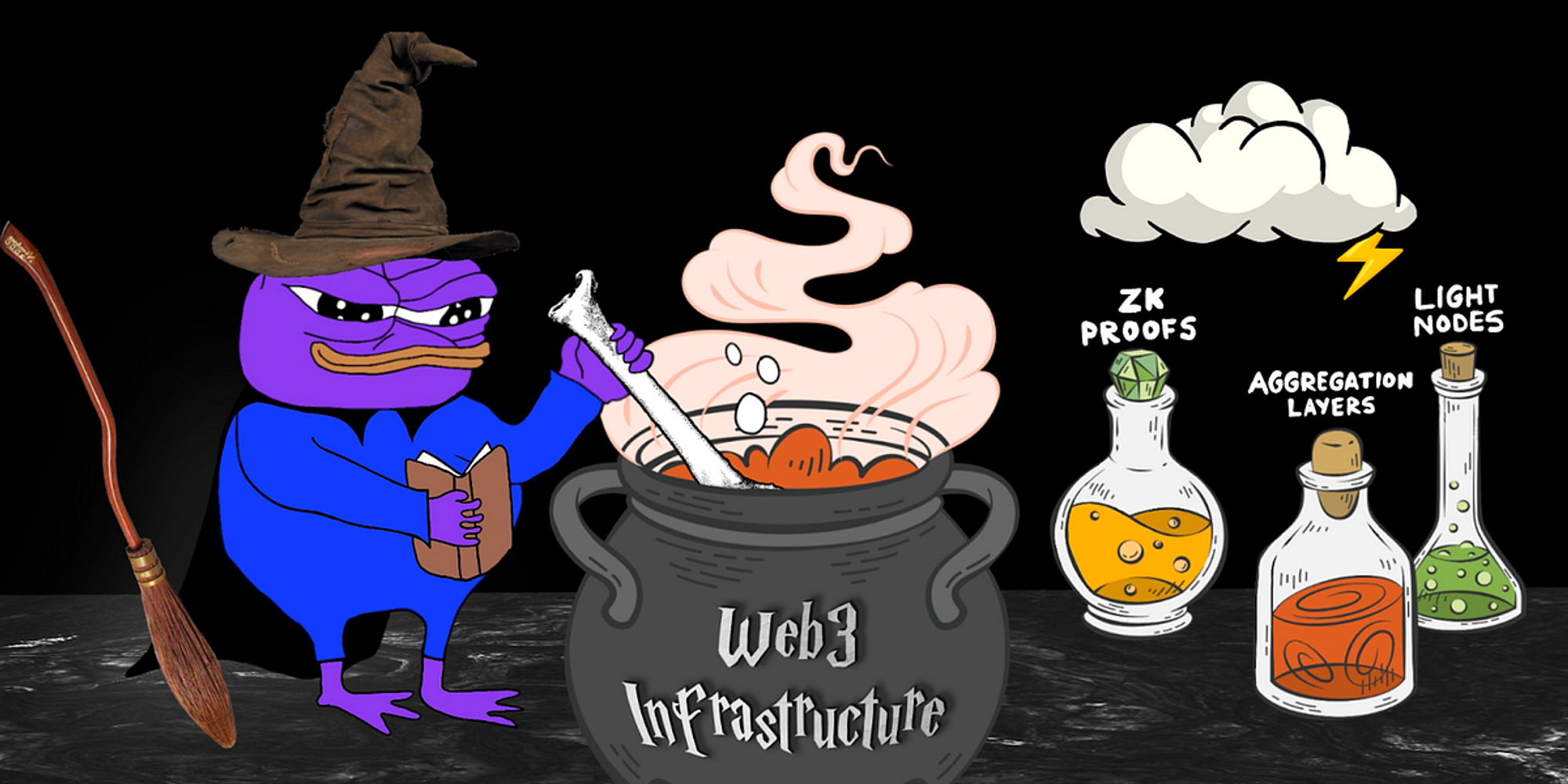
AI + blockchain sounds good, but what exactly is the addition?
One approach is through the ZK proof system. For example, to make a customized circuit for machine learning, the process of generating witness for the off-chain circuit is the process of model execution, and generating proof (including model parameters and input) for the process of model prediction, and anyone can verify the proof on the chain.
The AI model is still executed on an efficient cluster, and even some hardware acceleration is used to further increase the computing speed. While maximizing the use of computing power, it is ensured that no centralized person or organization can tamper with or interfere with the model, that is, to ensure:
Certainty of model predictions = verifiable (input + model architecture + parameters)
Based on the above practices, it can be further deduced which infras are crucial for AI on-chain:
ZKP system, rollup: Rollups expand our imagination of blockchain computing power, pack a bunch of transactions, and even recursively generate proof of proof to further reduce costs. For the current huge model, the first step to provide possibility is proof system and rollup;
Hardware acceleration: ZK rollup provides a verifiable foundation, but the generation speed of the proof is directly related to the usability and user experience of the model. It is obviously not working to wait for several hours to generate a proof of a model. Therefore, hardware acceleration through FPGA is obviously is a good boost.
Cryptography: Cryptography is the foundation of the blockchain, and the models on the chain and sensitive data also need to ensure privacy.
Replenish:
The basis of the large model is the GPU. Without the support of high parallelism, the efficiency of the large model will be very low, and it will not be able to run. Therefore, for a zk ecosystem on a chain:
GPU Friendly = AI Friendly
secondary title
2) Challenge: a more powerful proof system
The generation speed and memory usage of ZK Proof are very important. One is related to user experience and feasibility, and the other is related to cost and ceiling.
Is the current zkp system enough?
Adequate, but not good enough...
In the article "The Cost of Intelligence: Proving Machine Learning Inference with Zero-Knowledge", Modulus lab analyzed the specific situation of the model and computing power in great detail. If you have time, you can read this "No. 0 document-paper 0" of the ZKML session:
[https://drive.google.com/file/d/1 tylpowpaqcOhKQtYolPlqvx 6 R 2 Gv 4 IzE/view]
Following are the different proof systems mentioned in paper 0
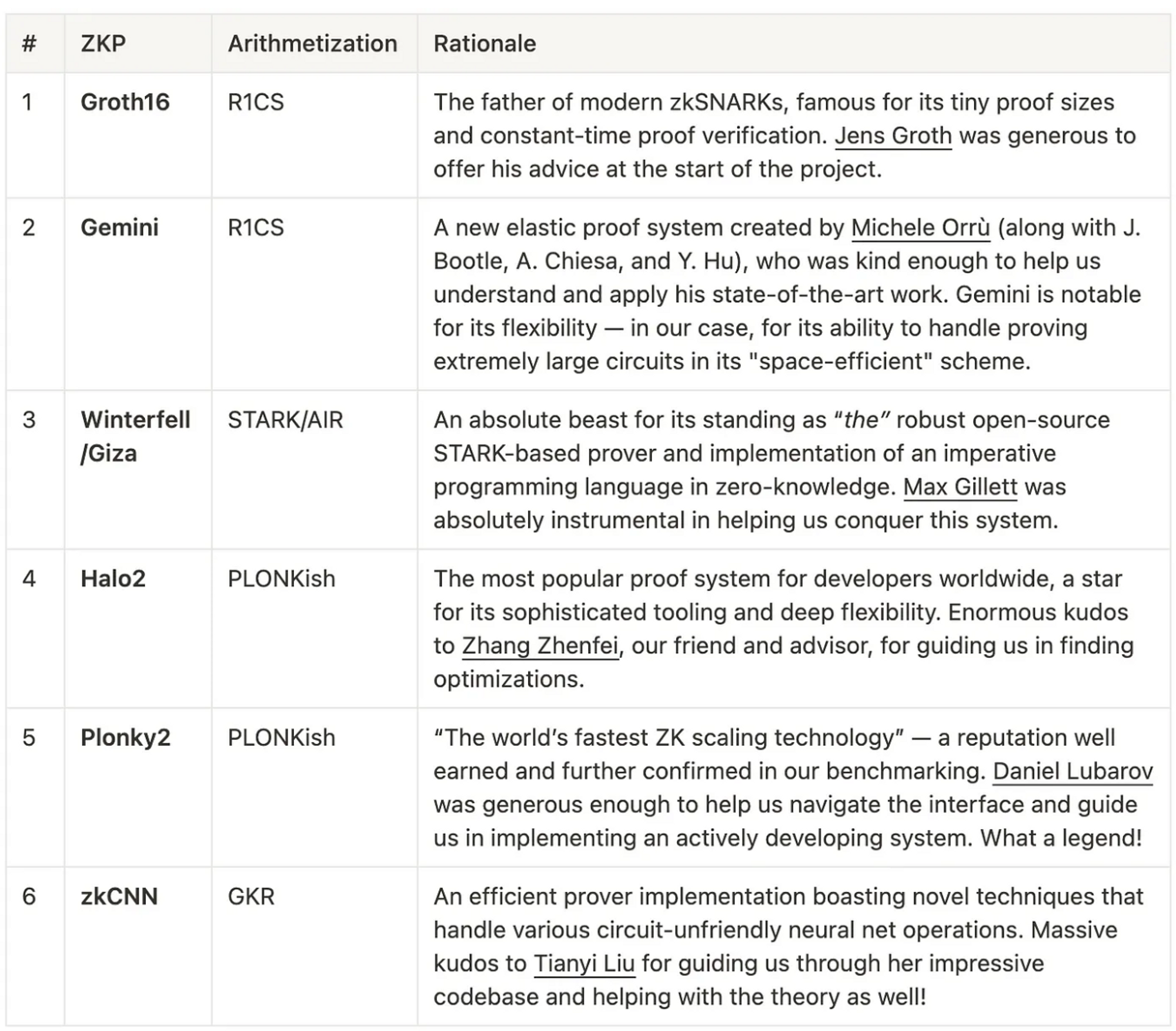
Based on the above zk algorithm, modulus lab conducts tests from the two dimensions of time consumption and memory usage, and controls the two core variables of parameters and layers in these two dimensions. The following are benchmark suites, such a design can also roughly cover from 60 k parameters of LeNet 5, 0.5 MFLOPs, to 22 M parameters of ResNet-34, 3.77 GFLOPs.

Time consumption test results:

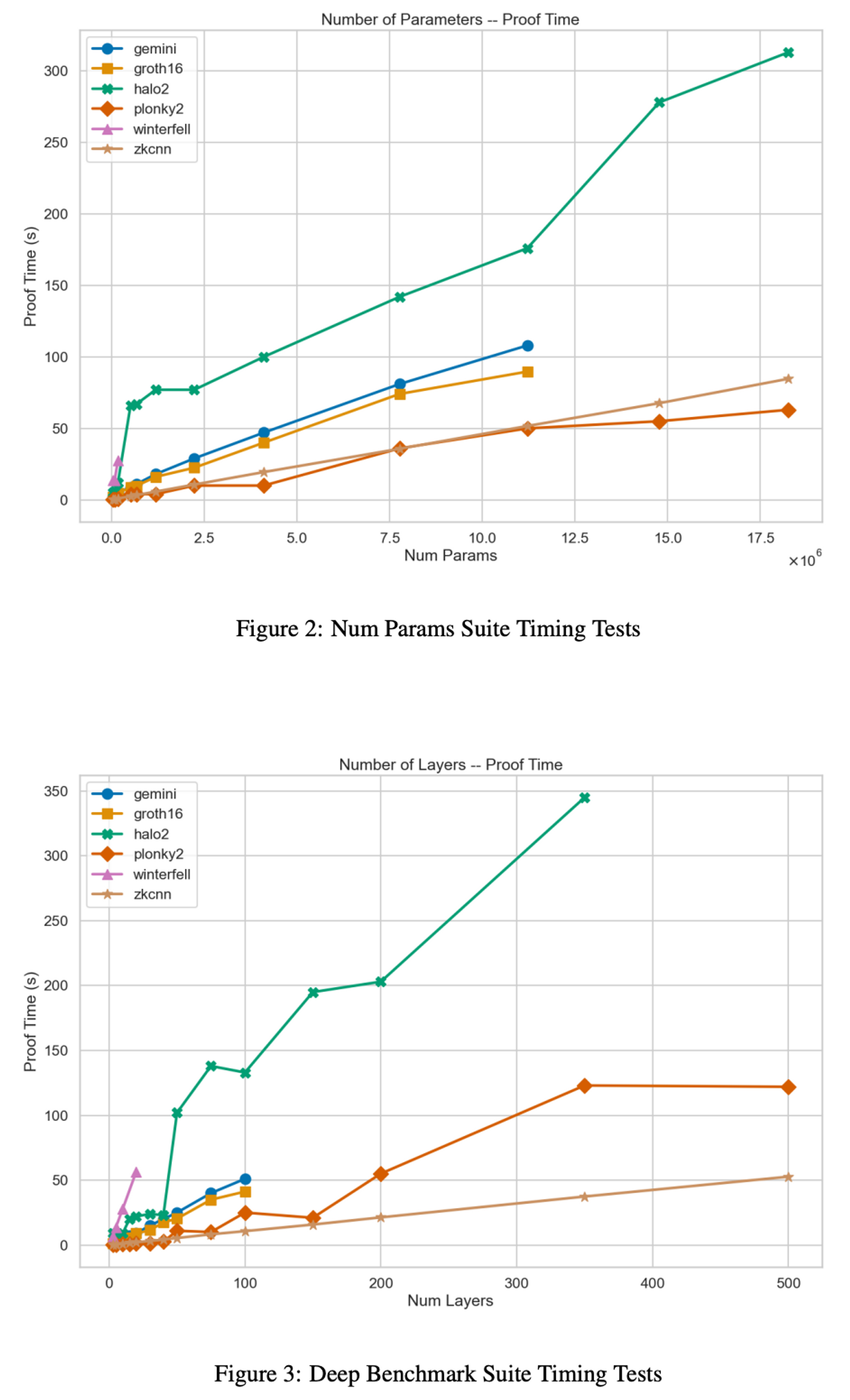
Test results of memory usage:
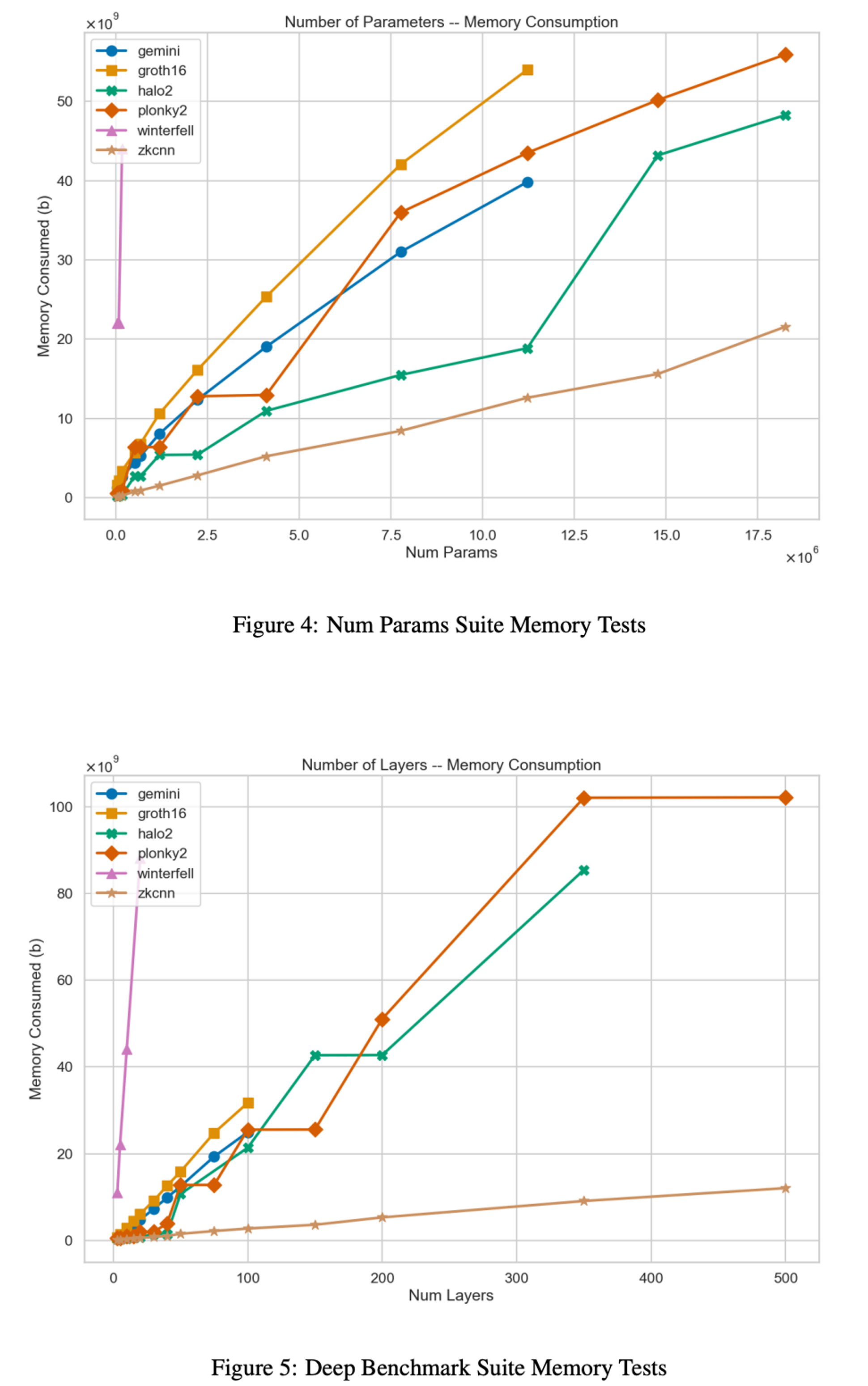
Based on the above data, overall, the current zk algorithm has the possibility to support the generation of proofs for large models, but the corresponding cost is still very high, requiring even more than 10 times of optimization. Taking Gloth 16 as an example, although it benefits from the optimization of computation time brought about by high concurrency, its memory usage increases significantly as a tradeoff. This is also verified by the performance of Plonky 2 and zkCNN in time and space.
So now the question actually changes from whether the zkp system can support AI on the chain toIs it worthwhile to support AI+Blockchain?And as the model parameters increase exponentially, the pressure on the proof system will also increase rapidly. Indeed, is there a trustless neural network now, no! It's because the cost doesn't count.
Therefore, create aAI customized proof systemfirst level title
3. Is the application worth looking forward to?
Although the AI on the chain is still in a very early stage, it may only be between the beginning and the development according to the above layers, but the direction of AI has never lacked excellent teams and innovative ideas.
As mentioned above, judging from the development stage of AI + Blockchain, the market is now inInception to intermediate stages of development, The product trial direction is still based on the optimization of user experience based on existing functions. But the most valuable thing is to use AI to change the main body of trustless from people to tools on the chain, subverting the original product form in terms of safety and efficiency.
secondary title
1) The Rockefeller Bot: The world's first on-chain AI
Rockefeller is the first on-chain AI product launched by the modulus lab team, which has a strong "commemorative value". This model is essentially a trading bot. Specifically, the training data of rockefeller is the price/exchange rate of WEth-USDC published on a large number of chains. It is a three-layer feedforward network model, and the prediction target is the future price of WEth. ups and downs.
The following is the process when the trading bot decides to trade:
Rockefeller generates ZKP for prediction results on ZK-rollup;
ZKP is verified on L1 (funds are kept by L1's contract), and operations are performed;
It can be seen that the forecasting and fund operations of the trading bot are completely decentralized and trustless. As mentioned above, rockefeller is more like a brand new Defi game from a higher dimension. Compared with trusting other traders, in this mode, users actually bet on the transparent + verifiable + autonomous model. Users do not need to trust centralized institutions to ensure the legitimacy of the model decision-making process. At the same time, AI can also eliminate the influence of human nature to the greatest extent, and conduct transactions more decisively.
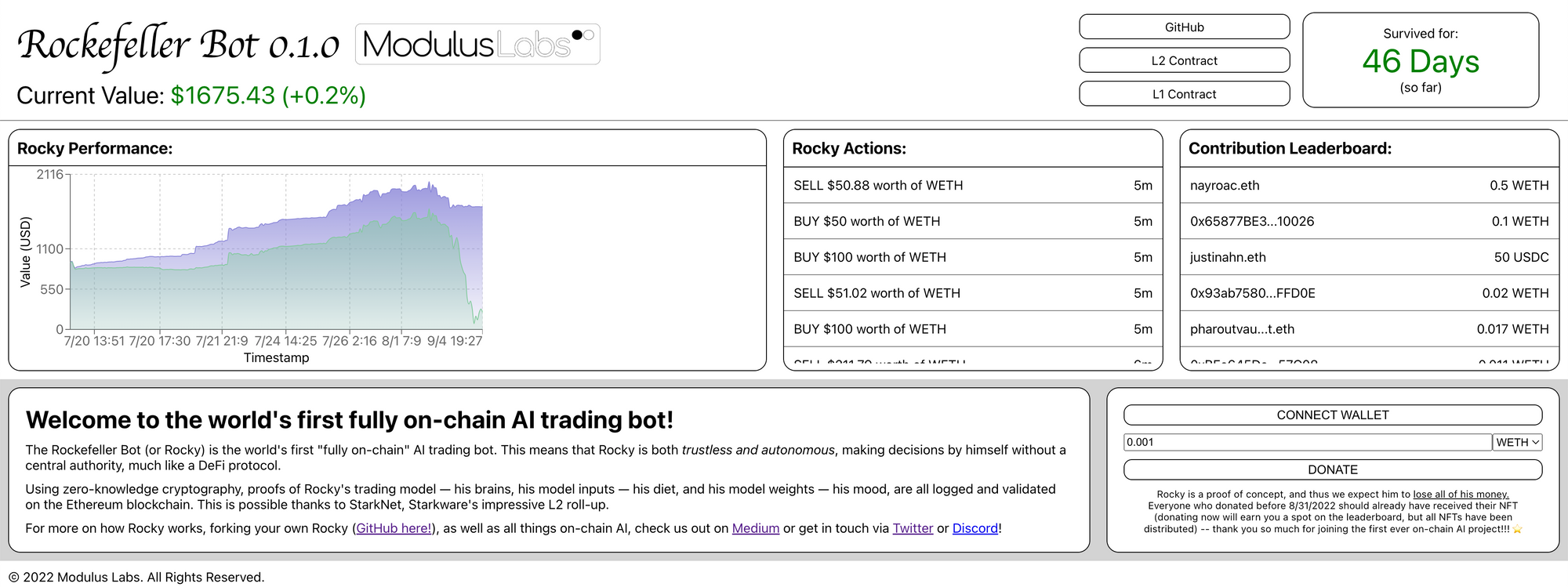
You might already be tempted to put some money into Rockefeller and have a go, but is it really going to make money?
Does not,secondary title
2) Leela: The world's first on-chain AI game
The recently released Leela vs the world is also from modulus lab. The game mechanics are simple, with human players forming a faction against the AI. In the game, players can bet on who will win the game in the end. After each match, the loser's pool will be allocated to the winner according to the number of pledged tokens.
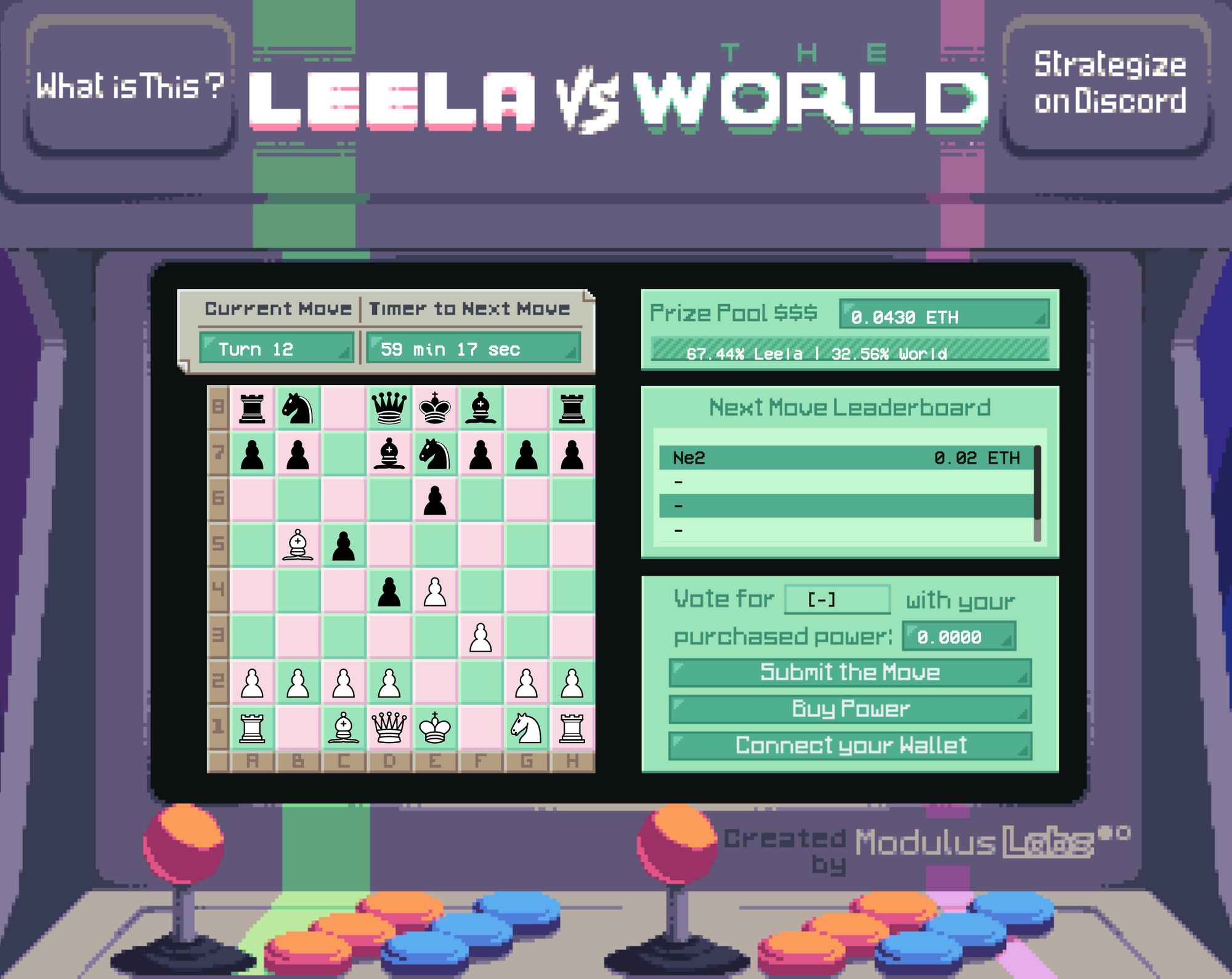
Speaking of on-chain AI, this time modulus lab deployed a larger deep neural network (number of Parameters > 3, 700, 000). Although Leela has surpassed rockefeller in terms of model scale and product content, in the final analysis this is still a large-scale on-chain AI experiment.The mechanism and operating mode behind Leela is what needs attention, which can help us better understand the operation mode and room for improvement of AI on the chain. The following is the official logic diagram:

Every move of Leela, that is, every prediction, will generate ZKP, and it will only take effect in the game after being verified by the contract. That is to say, benefiting from trustless autonomous AI, the funds and fairness of users betting are completely protected by cryptography and there is no need to trust game developers.
Leela uses the Halo 2 algorithm, mainly because its tools and design flexibility can help design a more efficient proof system. For specific performance, please refer to the above test data. But at the same time, during the operation of Leela, the modulus team also discovered the disadvantages of Halo 2, such as the slow speed of generating proofs, and it is not friendly to one-shot proving. Therefore, it further confirms the previous conclusion based on test data: if we need to bring a larger model into web3, we need to develop a more powerful proof system.
However, the value of Leela is that it brings us a greater imagination of AI + Web3 game,Players of Glory of Kings should hope that the King Matching Algorithm is fully on-chain at this moment:)secondary title
3 )Worldcoin:AI + KYC
Worldcoin is an on-chain identity system (Privacy-Preserving Proof-of-Personhood Protocol). It establishes an identity system through biometrics and realizes payment and other derivative functions. It solves the problem of fighting Sybil attacks. The current registered users exceed 1.4 m.
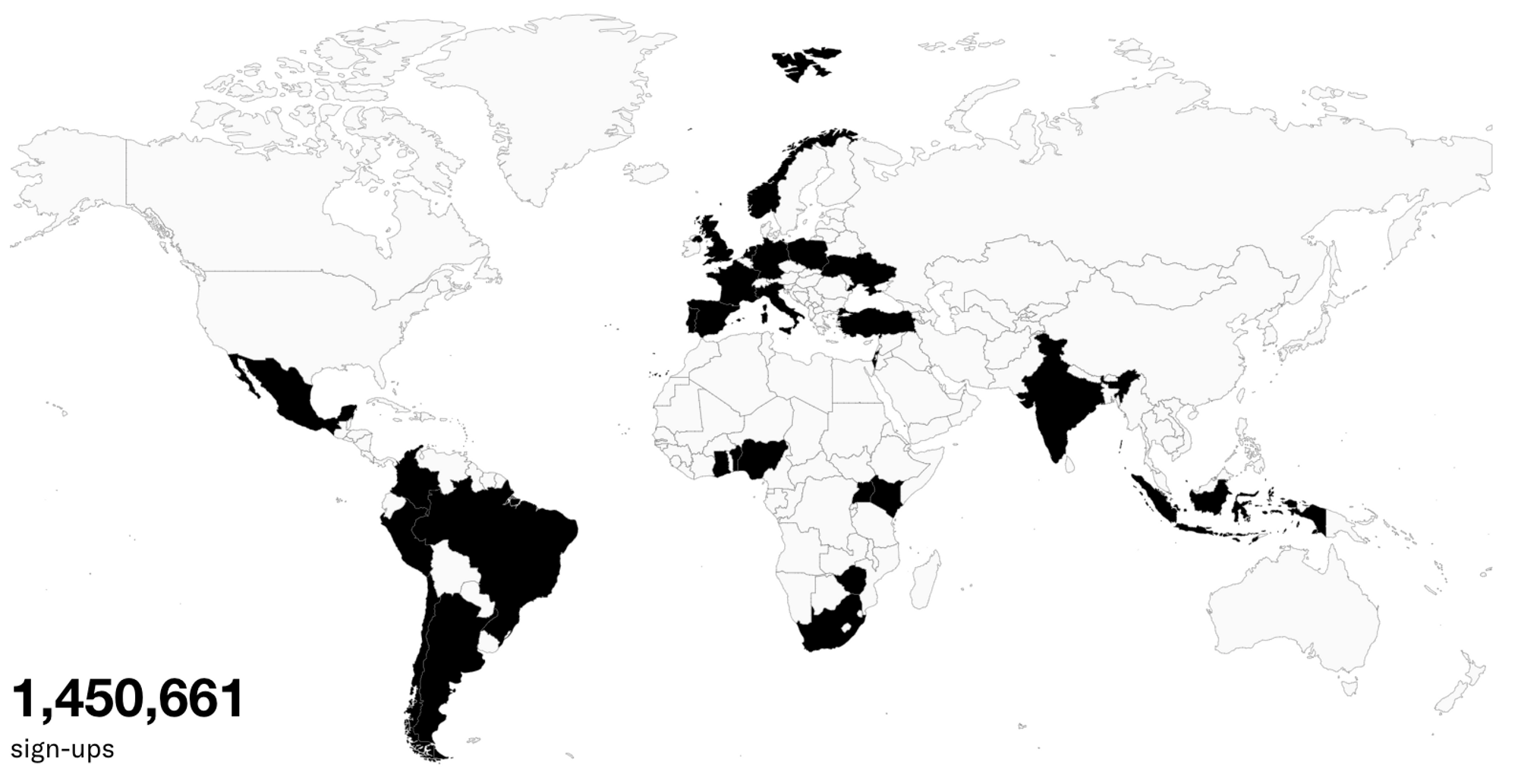
The user scans the iris through a hardware called Orb, and adds personal information to the database. Worldcoin runs the CNN model compression through the computing environment in the Orb hardware and confirms the validity of the user's iris data. Sounds strong, but if true decentralization of authentication is required, the worldcoin team is exploring the output of the verification model via ZKP.
challenge
secondary title
4) Other items
1. Pragma:Pargma is a ZK oracle developed from the starkware ecology. At the same time, the team is also exploring how to solve the problem of decentralized off-chain data verification through on-chain AI. Users no longer need to trust the validator, but use a sufficiently accurate and verifiable on-chain AI to complete the work of verifying the off-chain data source. For example, for the verification of actual assets or identities, AI can directly read the physical information of the photo printing as input and make decisions.
2. Lyra finance:Lyra finance is an option AMM that provides a derivatives trading market. To improve capital utilization, the Lyra team and modulus lab are collaborating to develop AMMs based on verifiable AI models. Based on a verifiable and fair AI model, Lyra finance has the opportunity to become a large-scale landing experiment of AI + Blockchain, bringing fair matchmaking to web3 users for the first time, optimizing the on-chain market through AI, and providing higher returns.
3. Giza:ZKML platform, deploying the model directly on the chain instead of verifying it off the chain,Nice try,but…Due to computing power and the fact that Cairo does not support CUDA-based proof generation, Giza can only support the deployment of some small models. This is also the most fatal problem. In the long run, it must be a large model that can have a disruptive impact on web3, and a model of this scale must have powerful hardware support, such as GPU.
4. Zama-ai:Homomorphic encryption of the model. Homomorphic encryption is a form of encryption, simply expressed as: f[E(x)] = E[f(x)], where f is an operation, E represents a homomorphic encryption algorithm, and x is a variable, for example: E( a) + E(b) = E(a + b). It is allowed to perform certain forms of algebraic operations on the ciphertext to obtain an encrypted result, and the result obtained by decrypting it is the same as that obtained by performing the same operation on the plaintext. The privacy of the model has always been a hotspot and bottleneck in the direction of AI + Blockchain. Although zk is friendly to privacy, zk is not equal to privacy. zama is dedicated to ensuring the privacy-preserving of model execution.
5. ML-as-a-service:first level title

4. Summary of AI + Blockchain
Overall, AI in the web3 world is at a very early stage, but there is no doubt that the maturity and popularity of onchain-AI will definitely bring the value of web3 to another level. From a technical point of view, the blockchain can provide AI with a unique infrastructure, and AI is also an important tool to change the production relationship of web3. The combination of the two can create many possibilities, which is also a place to be excited and open up imagination.
From the perspective of the power of AI on the chain, on the one hand,transparent + verifiableOn-chain AI transforms the decentralized and trustless subjects from humans to AI tools, which greatly improves efficiency and security, and provides the possibility to create new product forms; on the other hand, the blockchain infrastructure With continuous iteration, web3 really needs a killer application that can maximize the value of these infrastructures. ZKML just fits this point. For example, ZK-rollup is likely to be the entrance of AI into web3 in the future.
From the perspective of feasibility, the current infrastructure can support models of a certain scale to a certain extent, but there are still many uncertainties. At present, making a verifiable model through ZKP is the only way for AI to be on the chain, and it may also be the most deterministic technical path for bringing AI into web3 applications. But in the long run, the current proof system needs to be improved exponentially to support the increasingly large models.
first level title
Reference
https://medium.com/coinmonks/chapter-1-how-to-put-your-ai-on-chain-8 af 2d b 013 c 6 b
https://medium.com/@ModulusLabs/chapter-2-why-put-your-ai-on-chain-33 b 7625147 b 7
https://medium.com/@ModulusLabs/chapter-3-the-worlds-first-on-chain-ai-trading-bot-c 387 afe 8316 c
https://medium.com/@ModulusLabs/chapter-4-blockchains-that-self-improve-e 9716 c 041 f 36
https://medium.com/@ModulusLabs/chapter-4-5-trustless-ai-for-living-breathing-games-cc 9 f 24080 e 30
https://medium.com/@ModulusLabs/chapter-5-the-cost-of-intelligence-da 26 dbf 93307
https://medium.com/@ModulusLabs/chapter-6-leela-vs-the-world-the-worlds-1 st-on-chain-ai-game-17 ea 299 a 06 b 6
https://drive.google.com/file/d/1 tylpowpaqcOhKQtYolPlqvx 6 R 2 Gv 4 IzE/view
https://medium.com/@danieldkang/trustless-verification-of-machine-learning-6 f 648 fd 8 ba 88
Disclaimer: All Foresight Ventures articles are not intended as investment advice. Investment is risky, please assess your personal risk tolerance and make investment decisions prudently.
Foresight Ventures bets on the innovation of cryptocurrency in the next few decades. It manages multiple funds: VC fund, secondary active management fund, multi-strategy FOF, special purpose S fund "Foresight Secondary Fund l", with a total asset management scale of more than 4 One hundred million U.S. dollars. Foresight Ventures adheres to the concept of "Unique, Independent, Aggressive, Long-term" and provides extensive support for projects through strong ecological forces. Its team comes from senior personnel from top financial and technology companies including Sequoia China, CICC, Google, Bitmain, etc.
Website: https://www.foresightventures.com/
Twitter: https://twitter.com/ForesightVen
Disclaimer: All Foresight Ventures articles are not intended as investment advice. Investment is risky, please assess your personal risk tolerance and make investment decisions prudently.



